What if I told you that the future of mobile search was swiping.
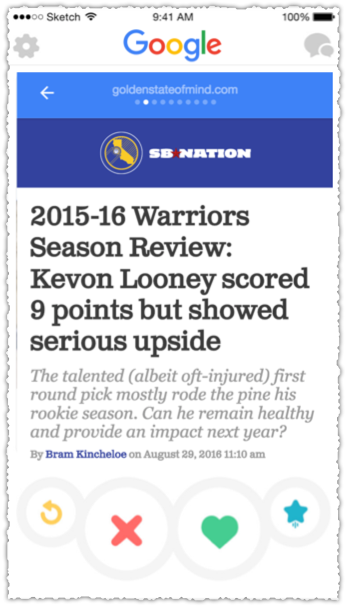
I don’t mean that there will be a few carousels of content. Instead I mean that all of the content will be displayed in a horizontal swiping interface. You wouldn’t click on a search result, you’d simply swipe from one result to the next.
This might sound farfetched but there’s growing evidence this might be Google’s end game. The Tinderization of mobile search could be right around the corner.
Horizontal Interface
Google has been playing with horizontal interfaces on mobile search for some time now. You can find it under certain Twitter profiles.
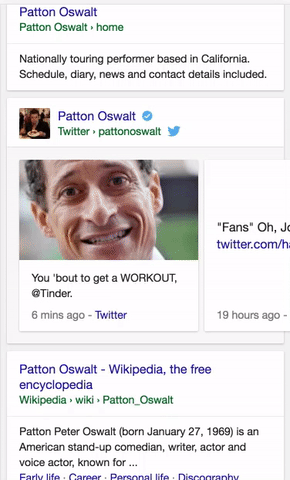
There’s one for videos.
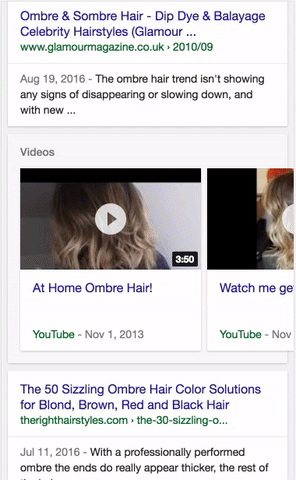
And another for recipes.
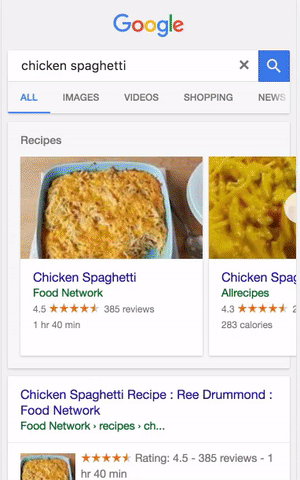
There are plenty of other examples. But the most important one is the one for AMP.
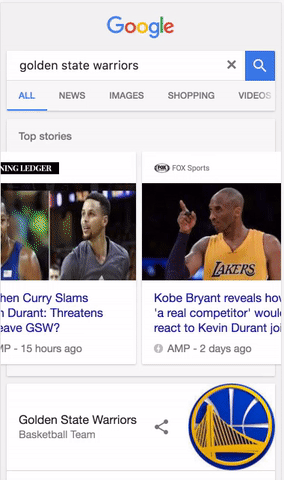
The reason the AMP example is so important is that AMP is no longer going to be served just in a carousel but will be available to any organic search result.
But you have to wonder how Google will deliver this type of AMP carousel interface with AMP content sprinkled throughout the results. (They already reference the interface as the ‘AMP viewer’.)
What if you could simply swipe between AMP results? The current interface lets you do this already.
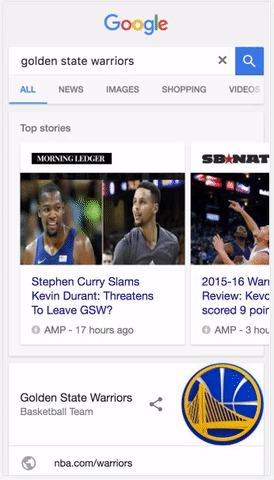
Once AMP is sprinkled all through the results wouldn’t it be easier to swipe between AMP results once you were in that environment? They already have the dots navigation element to indicate where you are in the order of results.
I know, I know, you’re thinking about how bad this could be for non-AMP content but let me tell you a secret. Users won’t care and neither will Google.
User experience trumps publisher whining every single time.
In the end, instead of creating a carousel for the links, Google can create a carousel for the content itself.
AMP
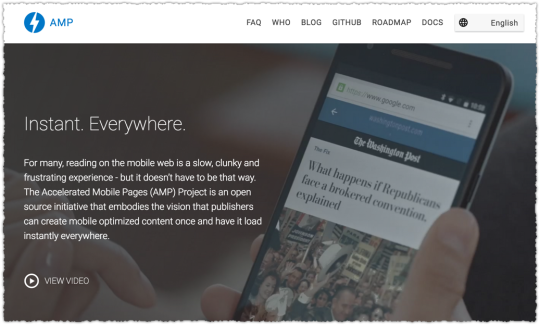
For those of you who aren’t hip to acronyms, AMP stands for Accelerated Mobile Pages. It’s an initiative by Google to create near instantaneous availability of content on mobile.
The way they accomplish this is by having publishers create very lightweight pages and then cacheing them on Google servers. So when you click on one of those AMP results you’re essentially getting the cached version of the page direct from Google.
The AMP initiative is all about speed. If the mobile web is faster it helps with Google’s (not so) evil plan. It also has an interesting … side effect.
Google could host the mobile Internet.
That’s both amazing and a bit terrifying. When every piece of content in a search result is an AMP page Google can essentially host that mobile result in its entirety.
At first AMP was just for news content but as of today Google is looking to create AMP content for everything including e-commerce. So the idea of an all AMP interface doesn’t seem out of the question.
Swipes Not Clicks
![]()
Why make users click if every search result is an AMP page? Seriously. Think about it.
Google is obsessed with reducing the time to long click, the amount of time it takes to get users to a satisfactory result. What better way to do this than to remove the friction of clicking back and forth to each site.
No more blue links.
Why make users click when you can display that content immediately? Google has it! Then users can simply swipe to the next result, and the next, and the next and the next. They can even go back and forth in this way until they find a result they wish to delve into further.
Swiping through content would be a radical departure from the traditional search interface but it would be vastly faster and more convenient.
This would work with the numerous other elements that bubble information up further in the search process such as Knowledge Panels and Oneboxes. Dr. Pete Meyers showed how some of these ‘cards’ could fit together. But the cards would work equally as well in a swiping environment.
How much better would it be to search for a product and swipe through the offerings of those appearing in search results?
New Metrics of Success

If this is where the mobile web is headed then the game will completely change. Success won’t be tied nearly as much to rank. When you remove the friction of clicking the number of ‘views’ each result gets will be much higher.
The normal top heavy click distribution will disappear to be replaced with a more even ‘view’ distribution of the top 3-5 results. I’m assuming most users will swipe at least three times if not more but that there will be a severe drop off after that.
When a user swipes to your result you’ll still get credit for a visit by implementing Google Analytics or another analytics package correctly. But users aren’t really on your site at that point. It’s only when they click through on that AMP result that they wind up in your mobile web environment.
So the new metric for mobile search success might be getting users to stop on your result and, optimally, click-through to your site. That’s right, engagement could be the most important metric. Doesn’t that essentially create alignment between users, Google and publishers?
Funny thing is, Google just launched the ability to do A/B testing for AMP pages. They’re already thinking about how important it’s going to be to help publishers optimize for engagement.
Hype or Reality?

Google, as a mobile first company, is pushing hard to reduce the distance between search and information. I don’t think this is a controversial statement. The question is how far Google is willing to go to shorten that distance.
I’m putting a bunch of pieces together here, from horizontal interfaces, to AMP to Google’s obsession with speed to come up with this forward looking vision of mobile search.
I think it’s in the realm of possibility, particularly since the growth areas for Google are in countries outside of the US where mobile is vastly more dominant and where speed can sometimes be a challenge.
TL;DR
When every search result is an AMP page there’s little reason for users to click on a result to see that content. Should Google’s AMP project succeed, the future of mobile search could very well be swiping through content and the death of the blue link.
The Next Post: What I Learned in 2016
The Previous Post: RankBrain Survival Guide

1 trackbacks/pingbacks
Comments About The Future of Mobile Search
// 16 comments so far.
Mandeep // August 29th 2016
It just makes sense for the user to be able to swipe left and right. I would hate to scroll down to find content. However, I also hate it when swiping left and right is buggy and doesn’t show the whole item. I have also seen this used by Facebook.
AJ Kohn // August 30th 2016
Thanks for your comment Mandeep. I think swiping makes a lot of sense on mobile. The real difference here will be that the content will be preloaded so you’ll simply swipe through the results. No clicking until you want to go to a website proper. I think it’s a huge win for users but it would be a huge difference in how sites optimize for mobile search.
Mark Traphagen // August 30th 2016
This instantly makes a ton of sense. In fact, as a user, I want to see it tomorrow. Nah, I want to see it by 5pm today!
The vertical links hierarchy often makes little sense and causes unearned monopolies at the top, when in reality there is often little, if any, appreciable difference in quality or user utility between result #1 and #10.
Horizontal sliding cards that actually display at least a preview of the content encourage browsing, allowing the reader to settle on what actually looks most interesting to her, instead of trusting that Google got it right with the topmost result.
For publishers, this allows content to compete more on its actual merits than on how good its link portfolio is (although this will not kill SEO; one would assume that fundamental SEO will still be necessary to qualify to at least get on the carousel ride.
It also could open up a whole new area of search optimization: expertise in optimizing the content previews that show in such an interface to encourage a click-through, a skillset that will carry over from Facebook sponsored content for one thing.
AJ Kohn // August 30th 2016
Glad you agree Mark! And at this stage in the maturity of Internet content there isn’t nearly the difference in quality/utility between result 1 and 10.
In some query spaces this will be more true than others but this isn’t 2003 where only the first few results were truly useful. So it would mean that users would be able to digest and review more content and select the one that is best suited to them. In particular, I think this could reduce the frustration for those who had a non-standard intent (i.e. – not the primary intent Google identified.)
For publishers it means that they would get a lot more visibility since the friction to get to their content would be cut dramatically. That means that content quality and … the presentation of that content would mean far more. Like you said, you’ll still need SEO to get into the carousel and you’ll likely need to be in the top … 6 to get the higher rates of visibility but after that the skillset would pivot – no doubt.
I personally think it would be a pretty bold move and one that both users, and ultimately publishers, would enjoy.
Ryan Glass // August 31st 2016
I strongly agree this is a possibility and a likelihood for at least a healthy portion of mobile search. I am also hopeful that moving to this will fix what is one of the most frustrating part of the current version of Google Now, that topics I’m highly engaged in are housed within one horizontal-scrolling frame that’s not easy to navigate without using both hands. I’d gladly click a “Yankees News” cart and swipe through the latest updates as AMP pages versus trying to decide what mobile sites to launch from a curtailed title and thumbnail.
I’m not convinced I see this becoming a 100% solution, as Google will surely still want to reward content-rich experiences if they can be delivered reliably on mobile. Otherwise I presume we’d see AMP-eligible gateway pages to launch a publisher’s app and get them out of the search environment entirely.
AJ Kohn // August 31st 2016
Thanks for the thoughtful comment Ryan. I think the experience in Google Now is one of the reasons Google is moving in this direction. Because it is a limitation. It’s a benign by annoying version of Russian roulette when you click on a link from Google Now.
I’m not sure how heavily this would be deployed but regarding apps, remember that they’re also experimenting with Android Instant Apps, which gives users a piece of a native app in mobile search. Perhaps even on an AMP page presentation. I’d sort of seen these as orthogonal paths but perhaps they do merge when you can deliver an app via AMP.
FiliFilzner // August 31st 2016
Somewhat agree for some types of content… but for scanning long lists of content, swipes are a bit of a nightmare.
Consider this: the eye can scan as you scroll. If I wanted to look through 100 items and pick out a particular item of interest, what is faster? Swiping back and forth 100 times until I find the items, and then maybe having to swipe another 25+ times to go to a secondary item… or scrolling through a list of 100 items with a couple flicks, letting my eyes do the work of scanning, and then being able to quickly flick back up and down to see previous items with a couple flicks.
I may be “old school”, but to me, scrolling through links is still the superior way to scan content, and won’t soon be replaced by swipe carousels as long as the lists are greater than a certain amount, probably no more than 6-10 items per carousel.
I give swipes as the future of all mobile interaction a hearty “meh”, and the predicted death of blue links a bit of a chuckle.
AJ Kohn // August 31st 2016
Thanks for your comment Fili. I guess I’m wondering what long lists of content you’re referring to here. Do you regularly have a SERP with more than 10 links?
Remember that once you’re in an AMP page you can scroll with in that page. So if it’s a BuzzFeed listicle you can certainly still scan that, except this time you wouldn’t have to click through to BuzzFeed to do so.
I’d also counter and say that we’ve become inured to scanning search results in this way, but mobile apps and other interactions have begun to train us on scanning content and making that snap decision. In fact, that’s what we do when we click-through and visit a site anyway. You’ve got a mere handful of seconds to convince the user that they’ve made the right choice and found the right content.
All this would do is move that interaction further up the funnel. “Is that what I want? No. Is this? Not really. Is this? Yes!” That type of scenario can happen in perhaps 3-5 seconds in this predicted interface. With a traditional links interface … you’d be looking at double or triple that.
aaron wall // September 01st 2016
“So the new metric for mobile search success might be getting users to stop on your result and, optimally, click-through to your site. That’s right, engagement could be the most important metric. Doesn’t that essentially create alignment between users, Google and publishers?”
If Google wants to keep eating as much as they can of the entire value chain there is little reason for them to stop at the first click. They could, say, prioritize related links from the same publisher that are AMP and/or prioritize publishers with a broad array of AMP content over those publishers who actually intend to get a clickthrough from giving Google free access to host their content.
If Google optimizes for “related reading” algos & put that in the content on the AMP page then it is going to be quite hard for the publisher to get much search traffic to their sites.
If Google is successful enough with getting wide adoption of AMP I could see them even adding in warnings that certain links go to non-AMP pages.
AJ Kohn // September 01st 2016
Thanks for the comment Aaron.
And you’re right. There’s a good chance that if this comes to fruition then they could serve up related pages or … if all the pages on a site have an AMP page, why ever leave the AMP environment?
Now, all those ‘views’ will count as visits in analytics packages. So I still feel like there’s value there but it’s just different. Scary but not necessarily bad. They are working to ensure publishers can monetize those AMP pages. In some ways, if you’re an ad based site you could get a lot more ad views in this new environment.
But where things would get bad fast is if publishers were losing the ability to convert users and have access to their inbox. Way back when, the GBuy team (aka Google Checkout) wanted to keep the relationship with the user and not pass on the email address and other identifying information to the site. I was at an eCommerce site at the time and we gave the GBuy team the bird when they made that a requirement.
So again, if Google disrupts the ability for publishers and users to connect in any meaningful way that will be very bad and would likely hurt AMP adoption. So if Google does want to serve not just the results, but the entire mobile web, then they’ll need to provide tools to capture email etc. on AMP pages.
But as it stands, if this came to fruition I think more sites would get more views (aka traffic). Whether that traffic is as valuable or how you make it valuable is debatable.
Beijaflor // September 01st 2016
I use the Cliqz Browser from a startup in Germany, which has an own integrated fast-search. There you receive the three most relevant results as cards to swipe. Directely in a drop down under the url bar. It’s super fast and easy to use. Only when I need to do deeper research, I let Cliqz forward my search request to a different search engine.
AJ Kohn // September 01st 2016
Very interesting Beijaflor. I’ll have to check Cliqz out. Thank you.
Richard // September 01st 2016
Thank you AJ for this great article and all for the comments. Fully agree that a horizontal, card-based interface is the future of mobile search.
Human beings are cognitively only able to process one result at a time (especially on-the-go, where even more things distract you than sitting in front of a screen).
Plus this interface supports decision-making and satisfies the demand for information for the NOW, for the very moment – also something what users would want when turning to their mobile. We probably do not want to go through 3.000 results on a small screen, but rather see the one relevant result on a card.
Only – in my opinion we do not have to ask site-owners to create AMPs. In fact, I would argue that AMPs are not the biggest use-case. All sites are.
At CLIQZ, we already do have this interface for our mobile browser/search-engine product already. Please check out the Android-Version
It is still a bit Germany-focused, but will expand soon; it also works for the most popular US-queries.
And yes – for many queries, you do not even have to click/tap; try e.g. “weather New York” or get information about the movie “the martian”.
I would love to hear your feedback!
AJ Kohn // September 01st 2016
Richard,
I’ll definitely take CLIQZ for a spin. Can you tell me what sort of adoption you’ve gotten or user metrics in terms of type of queries, number of results viewed per query etc. Anything you can share publicly or privately would be appreciated.
I appreciate your cognitive references as well. I didn’t put that in the piece but it’s certainly something I’m very keen on. Cognitive ease is a huge issue and I’m reminded of those apps that turn chucks of text into a word by word experience, allowing you to read faster.
aaron wall // September 01st 2016
Excellent point on Google Checkout withholding information harming adoption.
I think the differences between then and now are perhaps 2 key points
– greater desperation
– the 2-step technique
Modern web publishers are more desperate today than ecommerce websites were then. Back then ecommerce was still growing quickly, SEO was easy, etc. There was plenty of growth and plenty of other channels. Now the decline in CPMs tends to more than offset traffic growth for many publishers.The fire sale of Yahoo! certainly indicates that & recently the New York Times stated they were going to cut coverage of local cultural reviews & even topics like local crime. If a 100+ year old leading publisher in the financial capital of the world doesn’t have the margins to cover crime stories, who will cover them?
Google used to be more transparent with their roll outs. You could see the good and the bad both rather quickly. They’ve since learned to hype the benefits to drive adoption & then implement added frictions or cost later into the process after they’ve achieved a dominant position.
The mobile SEO story is a good example on this front. A couple years ago it was hyped as THE growth area, but by last year ad creep in the SERPs had grown so extreme that RKG saw YoY declines in mobile search clicks, even as Google saw rapidly growing mobile search usage. And the visitor value is far lower, with even companies like Tripadvisor suggesting the gap between mobile vs desktop or tablet is as much as 70%. Those who had to run harder to stand still are now being pitched that AMP & Facebook Instant Articles are the solution, but hopefully more people approach it with more skepticism before we get to the point that the NYT has to turn into a BuzzFeed knock off to make their margins work.
AJ Kohn // September 01st 2016
Aaron,
I agree that publishers are much more desperate than they were. I’d offer up GigaOm as a prime example of this issue. It’s just dreadfully tough to survive on a purely ad driven business. The ones that survive will get far better at targeting and rely less on Google as a reacquisition device and instead bring users back by other means.
Sadly, many publishers just got … lazy. They got tons of traffic from Google or Facebook and all that good retention marketing stuff got de-prioritized. So when the wind changed directions, they were still over-weighted on getting repeat traffic from Google and/or Facebook and were screwed.
While all that is true, I believe the AMP experience and this potential UX shift are going to be very popular with users. If it is, then Google and publishers have to figure out a model that supports that new paradigm. (Look at me throwing out ALL the buzzwords.) And like it or not Google will have the leverage. This is a lot like Amazon, who almost every publisher hates but … must deal with if they wish to survive.
Google will want publishers to survive because they understand the need for a robust ecosystem. You could almost see a case where Google would want to deliver more views to publishers via swipes so that the ads (powered mostly by Google) would get more views. Now if those aren’t performing you’ll run into issues but … at the beginning it should be a win/win for all but the advertiser.
But you better believe that, just like Amazon, Google will be looking to squeeze publishers so they can improve their margins. I don’t see that as evil, as some do, but it is certainly a very hardball business tactic.
Sorry, comments for this entry are closed at this time.
You can follow any responses to this entry via its RSS comments feed.